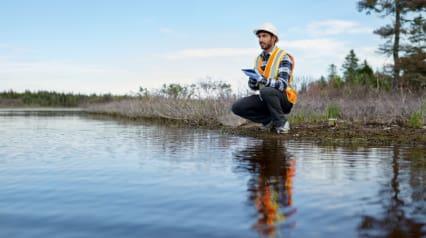What is Environmental Risk Assessment?
Environmental risk assessment (ERA) is a critical process used to estimate the probability of an adverse outcome of environmental changes caused by human activities. This follows the scientific process of hazard determination and the health risks associated with exposure to contamination. The result of the evaluation helps determine ways to remediate or remove environmental stressors and prevent or mitigate possible ecological damage.
Importance
Environmental risk management is a crucial measure that companies across industries should adopt, especially when planning a project that could impact people and their surroundings. The very first step in this process is risk assessment. Here are some reasons for its great value:
- Identify and understand environmental risks – Threats come in all shapes and sizes. Aside from determining each one, this process ascertains the quantitative and qualitative characteristics of the stressor.
- Develop apt and effective solutions – Getting detailed information as described above helps develop specific strategies for prevention and mitigation and prioritize tasks.
- Promote sustainability – The goal of sustainability is to “protect the planet from degradation… so that it can support the needs of future generations”. Environmental risk assessment and sustainable development are completely interconnected concepts because practicing the former is a commitment to affirm the latter.
- Compliance with duties and obligations – Conducting an ERA before the onset of any project or when a high-impact incident occurs is a must. Environmental agencies across the globe set hefty fines and penalties on companies that fall short of standards or fail to comply with these regulations.
- Ensure health and safety of all stakeholders – Protecting people and the ecology is of utmost importance. Man-made disasters like gas leaks, oil spills, and industrial fires cause injury, death, degradation of the environment, and a host of socio-economic problems. Many of these could be avoided if a thorough ERA was conducted.
Types of Environmental Risks
Environmental hazards like air pollution or waste leachate cause great harm to humans and their surroundings, which is why taking every single one into account through ERA is critical. Here are the different kinds of environmental risks that organizations, especially those in highly regulated industries, should keep an eye out for.
- Chemical hazards – Inhaling, swallowing, or coming into contact with these toxic chemicals can cause serious injuries, disease, and even death. The worst industrial accident involving chemicals happened in India in the mid-1980s when a dangerous gas escaped from a factory, killing nearly 20,000 people, injuring over half a million others, and contaminating the land surrounding it up to this day.
- Physical hazards – Noise pollution, radiation, and electromagnetic fields are examples of this environmental risk. The Chernobyl accident of 1986 is supposedly the result of a faulty reactor operated by a poorly-trained employee. Aside from the fatalities during the days after the explosion, hundreds were diagnosed with Acute radiation syndrome. Clean-up of the site continues today.
- Biological hazards – These may be invasive species, genetically-modified organisms, or disease-causing microbes. Although there is no definitive report regarding its origins, the COVID-19 virus shut down the world for almost two years. It killed nearly seven million people, infected over 760 million others, and triggered a global economic crisis.
- Habitat destruction – Unchecked deforestation, mining, and urbanization negatively impact individual species and the global ecosystem. Experts suggest that protecting just 50% of the total land and water mass can help save the planet. Although statistics show that only 15% of land and 7% of the ocean is safeguarded, the goal is still attainable if world leaders fully commit to it.
How is Environmental Risk Assessed?
Proper environmental risk assessment, whether it’s for human health, ecology, or both, observes the scientific process and considers these factors:
- Hazard identification – This answers the question: how much of the stressor is present? It involves collecting data about the various hazards and assessing their potential harm in an environmental medium (e.g., soil, water, and air) over a particular area.
- Exposure assessment – The next question asked is: how much is the exposure? This evaluates the likelihood and level of exposure to people, ecological receptors (other living organisms), and the environmental medium.
- Consequence evaluation – Also known as Dose-Response assessment, this answers the final question: how did or will the hazard affect humans or ecological receptors? This studies the hazard’s degree of toxicity and pathological threshold (e.g., concentration levels, length of exposure).
Based on the information gathered by evaluating the aforementioned factors, the final step of the process can be accomplished:
- Risk characterization – This presents the quality and quantity of the risk, forecasting the nature, probability, and gravity of its consequences today and in the years to come. This step is the most difficult of all because the information is rarely complete and details tend to get blurry along the way. The best way to deal with these uncertainties is to present them openly—data gaps and limitations included—so that proactive solutions can be determined.
Regulations
Countries and states or provinces have specific agencies enforcing the law regarding environmental risks. They may have differences in regulations depending on the situation on the ground, but all have the same general agenda and adhere to the systematic approach described above. Below are some government ERA methodologies:
- United Kingdom’s Environment Agency
- United States of America’s Environmental Protection Agency
- Australia’s Department of Climate Change, Energy, the Environment and Water
- India’s Ministry of Environment, Forest, and Climate Change
- Philippines’ Department of Environment and Natural Resources
Digitize the way you Work
Empower your team with SafetyCulture to perform checks, train staff, report issues, and automate tasks with our digital platform.
Get Started for FreeFAQs about Environmental Risk Assessment
The person responsible for this job is the risk assessor. This professional must have multi-disciplinary knowledge of risk management, ecology, toxicology, epidemiology, statistics, and several others. The environmental or health and safety officer of a company usually takes on this function.
ERA must be conducted before any project starts, upon detection of a new hazard, or when a management action could have an impact on humans and the environment.
Operations in high-risk industries such as industrial manufacturing, food and agriculture, energy production, and waste management must undergo proper ERA. But even small, low-risk businesses should conduct this when their processes involve any hazardous material.
These two processes are often interchanged or considered the same because of their numerous similarities. According to a report published by the Canadian Ministry of Environment, the difference lies in the approach. An ERA is focused on the current state of the environment and how a hazard could potentially affect it. Meanwhile, the EIA is centered on a particular project and its specific impact on the environment.




